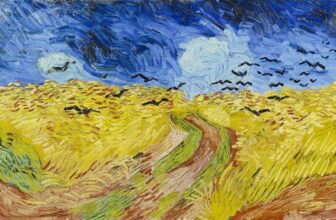Master Of Gardens Painting, Claude Monet
A Masterpiece of Color and Impressionism
Who is the Artist of Irises in Monet’s Garden?
Irises in Monet’s Garden is a mesmerizing painting created by the legendary French Impressionist artist, Claude Monet. Monet is best known for his series of water lilies, haystacks, and depictions of his own beloved garden at Giverny. The painting in question is one of several works in which he captures the lush beauty of irises blooming in his gardens.
Monet was a master of light and color, and his garden at Giverny became his greatest inspiration during the later years of his life. He dedicated himself to transforming his garden into a living work of art, and his paintings reflect his deep passion for nature. Irises in Monet’s Garden is one of these extraordinary works that showcase his fascination with the beauty of flowers and the ever-changing effects of light.
What is the Meaning of the Irises in Monet’s Garden Painting
The irises in Monet’s garden symbolize more than just flowers; they represent the fleeting nature of beauty, the harmony of nature, and the artist’s quest to capture light and movement. Monet’s Impressionist technique focused on capturing the momentary effects of sunlight and the shifting colors of the natural world.
In this painting, the irises are depicted in soft yet vibrant hues, blending into the surrounding greenery with dappled sunlight playing across the petals. The impressionistic brushstrokes give the painting an ethereal, almost dreamlike quality, inviting the viewer into a world of tranquility and contemplation.
Monet’s Irises in Monet’s Garden is also deeply personal. In his later years, Monet struggled with cataracts, which significantly affected his vision. His paintings during this period became increasingly abstract, with bold, expressive colors and blurred forms. The irises symbolize not only his love for his garden but also his determination to continue painting despite his failing eyesight.
Why is the Irises in Monet’s Garden Painting Famous?
Monet’s Irises in Monet’s Garden is famous for several reasons. Firstly, it is a quintessential example of Impressionism, a movement that revolutionized the art world by focusing on light, movement, and the artist’s perception rather than realistic details.
Secondly, the painting captures Monet’s unique ability to transform an ordinary scene into an extraordinary vision of color and emotion. His irises seem almost alive, swaying in an invisible breeze, bathed in sunlight that shifts and shimmers.
Additionally, Monet’s garden paintings are considered some of his most significant works. His Giverny series, including Water Lilies, Japanese Bridge, and Irises, have become cultural icons. Museums and collectors highly prize these paintings, and they continue to inspire artists and nature lovers worldwide.
Where are the Irises in Monet’s Garden Located?
The irises in Monet’s garden were located in his beloved home in Giverny, France. Monet meticulously designed the garden himself, carefully selecting and planting flowers that would provide a stunning array of colors throughout the seasons. The irises, with their deep purples, blues, and whites, were some of the most striking flowers in his collection.
Monet’s garden was divided into different sections, each bursting with different flowers and plants. The irises were planted in the Clos Normand, near the pathways that led visitors through an enchanting landscape of blossoms and greenery. Some were also placed around the famous lily pond, adding to the overall aesthetic that Monet sought to capture in his paintings.
When Did Monet Paint Irises in Monet’s Garden?
Monet painted Irises in Monet’s Garden during the late 19th and early 20th centuries, particularly in the 1900s. This period was one of the most prolific in his career, during which he devoted himself almost entirely to painting his gardens at Giverny.
By this time, Monet had achieved great success as an artist, and he had the means to cultivate a garden that would serve as his artistic muse. The irises, which bloomed in late spring and early summer, were among the many flowers that he depicted in his series of garden paintings.
Why Did Van Gogh Like Irises?
Vincent van Gogh, another legendary artist, also had a deep admiration for irises. In fact, his painting Irises (1889) is one of his most celebrated works. But why did Van Gogh like irises so much?
One reason is their vivid colors. Van Gogh had a unique ability to use bold, striking colors to evoke emotion in his paintings. The deep blues and purples of irises stood out to him as a perfect subject for his expressive, post-Impressionist style.
Another reason is their symbolic meaning. Van Gogh painted Irises while he was staying at the Saint-Paul-de-Mausole asylum in Saint-Rémy-de-Provence, where he was undergoing treatment for his mental health struggles. The irises in his painting are thought to represent hope, renewal, and a sense of calm amid turmoil. The gentle curves of the petals and the rhythmic movement of the flowers create a soothing, almost meditative effect.
Like Monet, Van Gogh saw irises as more than just flowers; they were a means of exploring color, emotion, and the beauty of nature.
Why Are They Called Irises?
The name “iris” comes from the Greek word for “rainbow.” In Greek mythology, Iris was the goddess of the rainbow and a messenger of the gods. The flower was named after her because irises come in a wide variety of colors, much like a rainbow.
Throughout history, irises have been associated with royalty, wisdom, and faith. In ancient Egypt, they were used in religious ceremonies, and in medieval France, they became the symbol of the monarchy, inspiring the famous Fleur-de-lis emblem.
A Timeless Inspiration
Monet’s Irises in Monet’s Garden remains one of the most breathtaking representations of the natural world in art history. Its dreamy, light-filled depiction of flowers swaying in the garden captures the essence of Impressionism and Monet’s lifelong devotion to beauty.
The painting’s fame is not only due to its artistic brilliance but also its emotional depth. It tells a story of Monet’s passion, his struggles with vision loss, and his unwavering desire to see and paint the world as he experienced it.
Both Monet and Van Gogh saw irises as a powerful source of inspiration, using them as symbols of life, change, and artistic expression. Today, the legacy of their work continues to enchant and inspire generations, proving that a simple flower can be transformed into a masterpiece. image/wikiart




